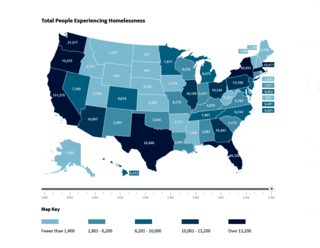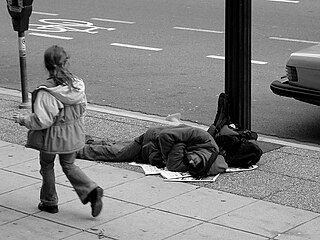
The Civil Rights Act of 1968 is a landmark law in the United States signed into law by United States President Lyndon B. Johnson during the King assassination riots.
Homelessness in Canada has grown in size and complexity since 1997. While historically known as a crisis only of urban centres such as Montreal, Laval, Vancouver, Edmonton, Calgary, and Toronto, increasing homelessness in suburban communities requires new services and resources.

Homelessness in the United States refers to the issue of homelessness, a condition wherein people lack "a fixed, regular, and adequate nighttime residence" as defined by The McKinney–Vento Homeless Assistance Act. Point-in-time single night counts prepared by shelter providers differ greatly from federal government accounts. In 2014, approximately 1.5 million sheltered homeless people were counted. The federal government statistics are prepared by the United States Department of Housing and Urban Development's Annual Homeless Assessment Report; as of 2018, HUD reported there were roughly 553,000 homeless people in the United States on a given night, or 0.17% of the population. Annual federal HUD reports contradict private state and local reports where homelessness is shown to have increased each year since 201 across several major American cities, with 40 percent increases noted in 2017 and in 2019. In January of 2018 the federal government statistics gave comprehensive encompassing nationwide statistics, with a total number of 552,830 individuals, of which 358,363 (65%) were sheltered in provided housing, while some 194,467 (35%) were unsheltered.

Homeless shelters are a type of homeless service agency which provide temporary residence for homeless individuals and families. Shelters exist to provide residents with safety and protection from exposure to the weather while simultaneously reducing the environmental impact on the community. They are similar to, but distinguishable from, various types of emergency shelters, which are typically operated for specific circumstances and populations—fleeing natural disasters or abusive social circumstances. Extreme weather conditions create problems similar to disaster management scenarios, and are handled with warming centers, which typically operate for short durations during adverse weather.
Trans bashing is the act of victimizing a person emotionally, physically, sexually, or verbally because they are transgender. The term has also been applied to hate speech directed at transgender people and at depictions of transgender people in the media that reinforce negative stereotypes about them. Trans and non-binary gender adolescents can experience bashing in the form of bullying and harassment. When compared to their cisgender peers, trans and non-binary gender youth are at increased risk for victimization, which has been shown to increase their risk of substance abuse.

The term unisex public toilets, also called gender-inclusive, gender-neutral and mixed-sex or all-gender toilets, bathrooms or restrooms, or just toilets, refers to public toilets that are not separated by gender or sex. Unisex public toilets can benefit a range of people with or without special needs. They are also valuable for parents who need to help their infant or young child with using the toilet. While the push for gender neutral bathrooms benefits a number of different demographics, it is driven by the transgender community to combat harassment and violence against these populations.

Homelessness is defined as living in housing that is below the minimum standard or lacks secure tenure. People can be categorized as homeless if they are: living on the streets ; moving between temporary shelters, including houses of friends, family and emergency accommodation ; living in private boarding houses without a private bathroom or security of tenure. The legal definition of homeless varies from country to country, or among different jurisdictions in the same country or region. United States government homeless enumeration studies also include people who sleep in a public or private place not designed for use as a regular sleeping accommodation for human beings. People who are homeless are most often unable to acquire and maintain regular, safe, secure and adequate housing due to income that is inconsistent or lacking altogether. Homelessness and poverty are interrelated. There is no methodological consent on counting the homeless and identifying their special needs; thus in most cities only estimated homeless populations are known.

Anti-homelessness legislation can take two forms: legislation that aims to help and re-house homeless people; and legislation that is intended to send the homeless to homeless shelters compulsorily, or to criminalize homelessness and begging.

The transgender rights movement is a movement to promote transgender rights and to eliminate discrimination and violence against transgender people regarding housing, employment, public accommodations, education, and health care. In some jurisdictions, transgender activism seeks to allow changes to identification documents to conform with a person's current gender identity without the need for sex reassignment surgery.
Transgender rights in the United States vary considerably by jurisdiction as the Supreme Court of the United States (SCOTUS) has only once ruled directly on transgender rights, in 2020; regarding the applicability of Title VII of the Civil Rights Act 1964, in the case of R.G. & G.R. Harris Funeral Homes Inc. v. Equal Employment Opportunity Commission, SCOTUS held that Title VII protections on sex discrimination in Employment extend to Transgender Employees.

Street people are people who live a public life on the streets of a city. Street people are frequently homeless, sometimes mentally ill, and often have a transient lifestyle. The delineation of street people is primarily determined by residential arrangement and their location in the urban setting. Certain neighborhoods, especially those in neighborhoods near universities, such as Telegraph Avenue in Berkeley, California, The Ave in Seattle, Washington, or the Pearl Street Mall in Boulder, Colorado often host street people. They may also frequent bohemian commercial districts such as Colfax Avenue in Denver. Individual street people may be familiar figures to the entire community.

Kevin Lee Faulconer is an American politician who served as the 36th mayor of San Diego. He was elected in a special election in February 2014, following the resignation of Bob Filner, and was sworn in as mayor on March 3, 2014. On June 7, 2016, he won election to a full term. Faulconer was not eligible to run in the 2020 mayoral election due to term limits.
Survival sex is a form of prostitution engaged in by a person because of their extreme need. It describes the practice of people who are homeless or otherwise disadvantaged in society, trading sex for food, a place to sleep, or other basic needs, or for drugs. The term is used by sex trade, poverty researchers, and aid workers.
The Homeless Bill of Rights refers to legislation protecting the civil and human rights of homeless people. These laws affirm that homeless people have equal rights to medical care, free speech, free movement, voting, opportunities for employment, and privacy. Legislation of this type is currently being debated at the state level in the United States. Over 120 organizations in five different states have shown public support for a Homeless Bill of Rights and are working towards its implementation. A Homeless Bill of Rights has become law in Rhode Island, Connecticut and Illinois and is under consideration by several other U.S. states, including California, Delaware, Minnesota, Missouri, Oregon, Tennessee, and Vermont.
Discrimination or prejudice against non-binary people, people who do not identify as exclusively male or female, may occur in social, legal, or medical contexts. Both cisgender and binary transgender people, including members of the lesbian, gay, and bisexual communities, can display such prejudice.
The Canadian Observatory on Homelessness (COH)—formerly named the Canadian Homelessness Research Network (CHRN)—is a Canadian non-profit, non-partisan research institute that works with researchers, service providers, policy makers, students and people who have experienced homelessness.

The San Francisco Bay Area comprises nine northern California counties and contains four of the ten most expensive counties in the United States. Strong economic growth has created hundreds of thousands of new jobs, but coupled with severe restrictions on building new housing units, it has resulted in an extreme housing shortage which has driven rents to extremely high levels. The Sacramento Bee notes that large cities like San Francisco and Los Angeles both attribute their recent increases in homeless people to the housing shortage, with the result that homelessness in California overall has increased by 15% from 2015 to 2017. In September 2019, the Council of Economic Advisers released a report in which they stated that deregulation of the housing markets would reduce homelessness in some of the most constrained markets by estimates of 54% in San Francisco, 40% in Los Angeles, and 38% in San Diego, because rents would fall by 55%, 41%, and 39% respectively. In San Francisco, a minimum wage worker would have to work approximately 4.7 full-time jobs to be able to rent a two-bedroom apartment.
Gary L. Blasi is Professor of Law Emeritus at UCLA and an active public interest lawyer and advocate in Los Angeles. Regarded as one of the best lawyers in California, he has been recognized for his legal and policy advocacy to end homelessness, eradicate slum housing conditions, and improve learning opportunities in substandard schools. His academic research draws on cognitive science and social psychology to better understand such problems as how people understand the causes of problems like homelessness or poverty, how advocates can best deal with the consequences of racial and other stereotypes, and how large bureaucracies can better respond to the needs of poor people and people living with disabilities.
A bathroom bill is the common name for legislation or a statute that defines access to public toilets by gender (restrooms)—or transgender individual. Bathroom bills affect access to sex-segregated public facilities for an individual based on a determination of their sex as defined in some specific way—such as their sex as assigned at birth, their sex as listed on their birth certificate, or the sex that corresponds to their gender identity. A bathroom bill can either be inclusive or exclusive of transgender individuals, depending on the aforementioned definition of their sex. Unisex public toilets are one option to overcome this controversy.

Homelessness in the United States has occurred to varying degrees across the country. The total number of homeless people in the United States fluctuates and constantly changes hence a comprehensive figure encompassing the entire nation is not issued since counts from independent shelter providers and statistics managed by the United States Department of Housing and Urban Development vary greatly. Federal HUD counts hover annually at around 500,000 people. Point-in-time counts are also vague measures of homeless populations and are not a precise and definitive indicator for the total number of cases, which may differ in both directions up or down. The most recent figure for the year 2019 that was given was at 567,715 individuals across the country that have experienced homelessness at a point in time during this period.









